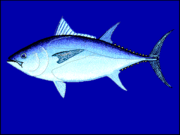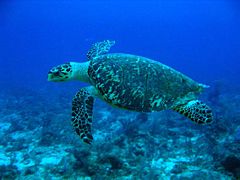Tag Archives: oil spill
18 baby dolphins found dead in the Gulf of Mexico
On February 21, three baby dolphins were found dead on the shores of Horn Island, and on February 22 the finding of a fourth carcass was confirmed by The Institute for Marine Mammal Studies (IMMS). This brings the amount of dead infant dolphins reported since January up to 18. Since the beginning of the year, 10 adult dolphins have also been found dead.
Located roughly 12 miles (20 km) south of Ocean Springs, Mississippi, Horn Island is one of several islands that make up the Gulf Islands National Seashore Park. National Resource Advisory employees are currently working with BP cleanup crews on the island.
Blair Mase, marine mammal stranding coordinator at The National Oceanic and Atmospheric Administration (NOAA) is concerned about the high number of wash up dead dolphins.
“We’re definitely keeping a close eye on this situation,” says Mase. “We’re comparing this to previous years, trying to find out what’s going on here.”
We are now early in the birthing season for dolphins in the area, and so far, 18 bodies of baby dolphins have been found where the baby was either stillborn or died shortly after birth.
“We’re trying to determine if we do in fact have still births,” says Mase. “There are more in Mississippi than in Alabama and Louisiana. With the oil spill, it is difficult. We’re trying to determine what’s causing this. It could be infectious related. Or it could be non-infection. We run the gamut of causes.”
The necropsy of the dead dolphins will hopefully help shed some light on the situation.
Scientists find huge smelly blob in Florida waters
Scientists researching the Gulf of Mexico have found an underwater mass of dead biological material that appears to be growing as microscopic algae and bacteria get trapped and die. The blob is at least three feet (90 cm) thick and spans two-thirds of a mile (1 mile = 1 609 meters) parallel to the coast just off the Florida Panhandle, within the site of Perdido Key. The blob smells like rotten eggs and feels similar to jelly.
The researchers have been unable to determine how the blob was formed, where it comes from or where it will go. Tests show that the material is nearly 100% biological and less than a year old. It is also clear that tiny organisms have gotten stuck in the sticky blob and died. Tests carried out by the researchers also showed that the blob has no connection to land.
“It seems to be a combination of algae and bacteria,” says David Hollander, a chemical oceanographer with the University of South Florida. According to Hollander, the substance is toxic and “extraordinarily sticky”.
Scientists are not ruling out a connection to last years’ Deepwater Horizon disaster, but so far none of the tests have shown any sign of oil.
Researchers encountered the blob for the first time in December as they were searching for oily sediments on the sea floor. They did find such sediments, but they also got a tip about something weird floating around roughly half a mile from Perdido Pass and this caused them to change their plans and head over to the area to investigate.
The environment where the blob can be found is a relatively pristine sloping shelf. Normally, wave action will sweep away any sediments here.
Hollander and his team are planning to return to the blob within a few weeks to gather more samples, since they were unable to get any material from the bottom of the blob during their last visit. They will also try to map out the entire blob to be able to see exactly how big it is.
Explorations of Seafloor Discover Life Near Well
Researchers have been going on dives into the Gulf of Mexico utilizing a mini-sub to take a gander at how the ecosystems are dealing with the recent BP oil fiasco.
It may seem like the Gulf of Mexico is a muddled mass of black goo and completely devoid of life, however that is not the case.
This past November, the three man mini-sub dove every day from the back end of the science boat Atlantis, which is the property of the Woods Hole Oceanographic Institution.
Every day the Alvin came bearing gifts of mud from the seabed, red rock samples, and seawater.
However, one fine day, close to Thanksgiving, the Alvin brought up something amazing – Signs of life.
A professor of marine sciences with the University of North Carolina, Andreas Teske, really was astonished by the find.
He has described a scene you wouldn’t expect to see near ground zero of the BP oil fiasco. Mussel beds, white and orange carpets of bacteria, and even shrimp fish and sea cucumbers.
These survivors were all making their homes around an underwater lake, made of brine, which has been cleverly dubbed “Dead Crab Lake” due to the fact that anything that stays in too long gets pickled.
“You could see the surface of the brine pool just like the surface of a garden pond, totally clear,” Teske explains. “And in the brine pond, some animals that fell in got pickled — some crabs and others. So once they fall in, if they don’t manage to climb out quickly, that’s it!”
It’s good to see that nature once again proves that it will take more than a small little oil fiasco to take it down.
USM’s Gulf Coast Research Lab Looking into Impact of BP Oil Spill

Even though the fiasco is being steadily swept under the carpet, and media coverage is dropping off quickly, the actual impact the fiasco has had is very much still on the minds of researchers and scientists.
There are a lot of unanswered questions about the actual impact BP’s blunder has had on the environment. These questions include: Where has the oil gone? ; What impact will it have on fisheries? ; What are the long term implications? And other such questions are all being delved into, even as this article is being written.
A leading goup of scientists working around the clock to get to the bottom of such things can be found at USM’s Gulf Coast Research Lab in Ocean Springs.
In fact, some of the answers may lie within some enormous, colorful crabs which make their home in the deep, dark waters, of the Gulf of Mexico.
Harriet Perry, a researcher with the team, has been studying these crabs since the 1980’s.
You see, the crabs are being tested for the presence of oil and dispersant as well as any other chemicals that BP may have inadvertently left behind after their little mishap this past summer.
Well, it’s good to see someone still gives a hoot as to what happens out there in the gulf, but with dwindling interest, it will only be a matter of time until the whole thing becomes nothing more than an idle stormy day story…
Deaths Caused by BP Oil Disaster Tallied UP and Estimated

The group has put together some rough numbers from eyes on the ground, including the U.S. Fish and Wildlife Service and the National Oceanic and Atmospheric Administration.
So, what exactly are the current numbers of dead as of the November 1st report?
The latest numbers are as follows: 6,104 deceased birds, 609 perished sea turtles, and 100 dead mammals, which include those lovable creatures, dolphins. The estimate is a count which tallies up the results from five different states: Alabama, Florida, Louisiana, Mississippi, and of course, Texas.
Now, we must take a moment here, and say that these were the deaths recorded in the area, and upon first glance. Not all of the aforementioned deaths were necessarily because of the huge mess BP made in the Gulf Of Mexico. The final COD, cause of death, is going to be determined later.
When specimens are discovered, or trapped, they get their own very special ID numbers. After the initial counting, a more thorough autopsy will take place to look for things like black goo in the throat, mouth and eyes, as well as a necropsy to see if BP’s big mess is indeed to blame.
The report released also shows the numbers of live animals and birds which were observed to have been alive and well, if a bit gooey and black. The numbers don’t look good for BP. Of 535 sea turtles collected, 456 were visibly covered in the black goo…
So, looks like BP is going to have some more explaining to do!
BP Sand Shark Still on the Hunt for Tar Balls, Is It Enough?
The contract crews from BP have marched onwards to Pensacola Beach, cleaning up tar balls by hand, however the national seashore’s supervisors were saving the heavy equipment until the Turtle and Bird mating season was over and done with, lest they disturb them even more than the spill itself did.
For the moment, scores of workers are removing and cleaning away tar balls with their bare hands. Morris commented that the crews are cleaning things away much more effectively now that the weather has cooled down and the laborors now have more experience in collecting the tar balls from the sand.
However, it is now time to stop messing around, and call in the big guns to get the mess cleared away. Jason Bragg, who is in charge of the machine removal of the tar balls from Panhandle beaches, has commented that while the Sand Shark isn’t a “rocket ship”, it is quite thorough, and removes all objects from the sand which are bigger than three millimeters – about the same size as the needles are across in a tattoo parlor.
This machine is eleven feet tall, weighs in at about 35 tons, has a top speed if two miles and hour and is manned by a skeleton crew of between six and ten people. In roughly one day – two ten hour shifts – the machine can clear away an area of sand which is eight feet wide and one and a half miles long. At this rate though, the beaches won’t be cleaned until late 2011 if then…
Case Study: BP Oil Spill Take Toll on Bluefin Tuna, Satellites Don’t Lie!

The amazing Atlantic bluefin tuna, some of the largest of this species of fish can be as large as a Volkswagon Beetle, make their way to the Gulf every year from January until June. The peak time when they spawn is about mid April to May – just as BP was giving out free samples of its precious oil, when the well they had exploded and started pumping thousands of gallons of crude into the area this past April 20th.
This fish, which is paramount to commercial markets everywhere, mate in the surface waters, the females lay their eggs and the males fertilize away behind them. The oil present could cause harm to the eggs, larva and even the adults in the area. To make matters worse, the Atlantic tuna populations of the world have seen a drastic decline of 82% over the past three decades, so it is extremely important that they be allowed to mate without interruption.
Well, great job BP.. You really did cause quite the disturbances… How would they like it if we dumped oil into their beds as they were getting in the mood?
USF Scientists: Ultraviolet Diagnostics show “Contaminated” Beach
A scientists with the University of South Florida Coastal Research Lab just recently took a gander at the Walton County beaches using a UV light and has commented they are “still contaminated” following the BP oil spill fiasco in the Gulf of Mexico.
A graduate student, Rip kirby, took a high-powered UV light over one length of the beach, and the light showed bits and areas all over the place of what he calls “accumulation of petroleum product and dispersant.” He issued a public apology for not getting around to taking the samples at an earlier date.
“This beach is just as contaminated as the rest, I’m sorry,” Kirby commenting, he added, “I took the local government officials’ word that these beaches were not impacted and stopped my testing in Destin.”
Joe Preston, the driector of Walton County Emergency Operations, saw fit to not return any of a multitude of calls from the papers. Cecilia Jones and Scott Brannon, Walton County Commissioners, also did not see fit to return calls. The Sheriff’s Office, surprise surprise, was also not attending to any questions on the matter.
Kirby, who dwells in the Fort Walton Beach area, and his team of colleagues from the USF have been digging deeper into the effects the spill has had on the local environment, and their findings were published in National Geographic this past July. However, the beaches were worse for wear, and Kirby stopped investigation because the officials said everything was fine..
So, who is trying to cover up for who here? What sort of scandal awaits? Only time will tell.. That is, if people see fit to answer their phones…
Something Fishy Going On With Massive Fish Death

The Louisiana Department of Wildlife and Fisheries released a statement the day after the fish started turning up dead stating that the cause of death for the fish was low levels of oxygen, and was not related to to the BP oil Spill fiasco.
The director of the Coastal Zone Management Department, P.J. Hahn, has pointed out that the Louisiana Department of Wildlife and Fisheries came to the conclusion without bothering to take any water samples, or fish samples in the affected area. This is where things get fishy. If you are testing things, and I’m no scientist, but you need to take samples, otherwise what are you basing your data on? The commentary of some dead fish?
P.J. Had this to say on the matter “ We had three fish kills in eight days, all in areas that were heavily oiled during the Deep Horizon Oil spill. The first was in Chaland Pass, the second near Bay Joe Wise and the third was in Bay Robinson. All kills covered areas approximately two square miles in size. I collected water and fish samples and turned them over to our DA’s office. Early independent testing results show the fish have oil in their gills and liver. Now a more detailed testing will indicate the fingerprint of the oil to see if it matches the BP Deep Horizons oil.”
Uh Oh.. Data Manipulation anyone? Conspiracy? Will BP now have one more nail in their coffin and be sent to sleep with the fishes?
Attempts to Move Se Turtle Eggs Out of Gulf Oil Spill Proving Fruitful
We have all heard of the BP oil spill fiasco in the Gulf of Mexico. As the black goo made its way to the beaches of Alabama and Florida officials of those states began an effort to attempt to save the batch of sea turtles.
Their plan was to dig up thousands of the turtle eggs and then move them over to the Kennedy Space Center, so that they could be born in an oil free environment. As we know, not many sea turtles actually make it in the wild, they didn’t need the extra obstacle of coming into the world in an oil slick.
If even a few of these turtles survived, officials commented, it would be considered a grand success.
Based on the first raw data coming in, “it’s been more of a success than we thought it would be,” a spokesman for the US Fish and Wildlife Service, Chuck Underwood, commented this past Friday.
Of the thousands – somewhere over 25,000 – of eggs moved, 14,676 were hatched successfully and were then let go in the Atlantic Ocean. This means that over half of the turtle eggs which were moved actually hatched, and nearly 6 out of every 10 turtles made it into the black goo free water.
“We do feel it was a success that we got that number of hatchlings into the sea,” commented a spokeswoman for the Florida Fish and Wildlife Conservation Commission, Patricia Behnke. “Of course, what happens to them after that, we don’t know. But we never do.”

